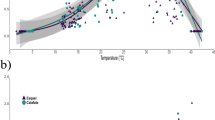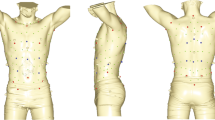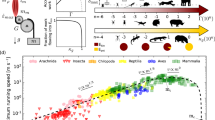Abstract
The fastest gait and speed of the largest theropod (carnivorous) dinosaurs, such as Tyrannosaurus, is controversial. Some studies contend that Tyrannosaurus was limited to walking, or at best an 11 m s-1 top speed1,2,3,4, whereas others argue for at least 20 m s-1 running speeds5,6,7. We demonstrate a method of gauging running ability by estimating the minimum mass of extensor (supportive) muscle needed for fast running. The model's predictions are validated for living alligators and chickens. Applying the method to small dinosaurs corroborates other studies by showing that they could have been competent runners. However, models show that in order to run quickly, an adult Tyrannosaurus would have needed an unreasonably large mass of extensor muscle, even with generous assumptions. Therefore, it is doubtful that Tyrannosaurus and other huge dinosaurs (∼6,000 kg) were capable runners or could reach high speeds.
This is a preview of subscription content, access via your institution
Access options
Subscribe to this journal
Receive 51 print issues and online access
$199.00 per year
only $3.90 per issue
Buy this article
- Purchase on SpringerLink
- Instant access to full article PDF
Prices may be subject to local taxes which are calculated during checkout



Similar content being viewed by others
References
Alexander, R. McN. Mechanics of posture and gait of some large dinosaurs. Zool. J. Linn. Soc. 83, 1–25 (1985).
Alexander, R. McN. Dynamics of Dinosaurs and Other Extinct Giants (Columbia Univ. Press, New York, 1989).
Horner, J. R. & Lessem, D. The Complete T. rex (Simon & Schuster, New York, 1993).
Farlow, J. O., Smith, M. B. & Robinson, J. M. Body mass, “strength indicator”, and cursorial potential of Tyrannosaurus rex. J. Vert. Paleont. 15, 713–725 (1995).
Bakker, R. T. Dinosaur Heresies (William Morrow, New York, 1986).
Paul, G. S. Predatory Dinosaurs of the World (Simon & Schuster, New York, 1988).
Paul, G. S. Limb design, function and running performance in ostrich-mimics and tyrannosaurs. Gaia 15, 257–270 (2000).
Christiansen, P. Strength indicator values of theropod long bones, with comments on limb proportions and cursorial potential. Gaia 15, 241–255 (2000).
Farlow, J. O., Gatesy, S. M., Holtz, T. R. Jr, Hutchinson, J. R. & Robinson, J. M. Theropod locomotion. Am. Zool. 40, 640–663 (2000).
Irby, G. V. Paleoichnological evidence for running dinosaurs worldwide. Mus. N. Arizona Bull. 60, 109–112 (1999).
Coombs, W. P. Jr . Sauropod habits and habitats. Palaeogeogr. Palaeoclimatol. Palaeoecol. 17, 1–33 (1975).
Roberts, T. J. Muscle force and stress during running in dogs and wild turkeys. Bull. Mus. Comp. Zool. 156, 283–295 (2001).
Biewener, A. A. Scaling body support in mammals: limb posture and muscle mechanics. Science 245, 45–48 (1989).
Roberts, T. R., Chen, M. S. & Taylor, C. R. Energetics of bipedal running. II. Limb design and running mechanics. J. Exp. Biol. 201, 2753–2762 (1998).
Hutchinson, J. R. The Evolution of Hindlimb Anatomy and Function in Theropod Dinosaurs. PhD thesis, Univ. California (2001).
Carrano, M. T. & Hutchinson, J. R. The pelvic and hind limb musculature of Tyrannosaurus rex (Dinosauria: Theropoda). J. Morphol. (in the press).
Alexander, R. McN., Jayes, A. S., Maloiy, G. M. O. & Wathuta, E. M. Allometry of the leg muscles of mammals. J. Zool. 194, 539–552 (1981).
Bennett, M. B. Allometry of the leg muscles of birds. J. Zool. 238, 435–443 (1996).
Grand, T. I. Body weight: its relation to tissue composition, segment distribution, and motor function. II. Interspecific comparisons. Am. J. Phys. Anthropol. 47, 211–240 (1977).
Hallgrimsson, B. & Maiorana, V. Variability and size in mammals and birds. Biol. J. Linn. Soc. 70, 571–595 (2000).
Gatesy, S. M. Guineafowl hind limb function. I: Cineradiographic analysis and speed effects. J. Morphol. 240, 115–125 (1999).
Johnston, I. A. Sustained force development: specializations and variation among the vertebrates. J. Exp. Biol. 115, 239–251 (1985).
Blickhan, R. The spring-mass model for running and hopping. J. Biomech. 22, 1217–1227 (1989).
Alexander, R. McN. The maximum forces exerted by animals. J. Exp. Biol. 115, 231–238 (1985).
Cavagna, G. A., Heglund, N. C. & Taylor, C. R. Mechanical work in terrestrial locomotion: two basic mechanisms for minimizing energy expenditure. Am. J. Physiol. 233, 243–261 (1977).
Alexander, R. McN. & Jayes, A. S. A dynamic similarity hypothesis for the gaits of quadrupedal mammals. J. Zool. 201, 135–152 (1983).
Alexander, R. McN., Maloiy, G. M. O., Njau, R. & Jayes, A. S. Mechanics of running of the ostrich (Struthio camelus). J. Zool. 187, 169–178 (1979).
Mendez, J. & Keys, A. Density and composition of mammalian muscle. Metabolism 9, 184–188 (1960).
Acknowledgements
We thank F. C. Anderson, K. Angielczyk, S. Delp, R. J. Full, S. M. Gatesy, T. M. Keaveny, R. Kram, K. Padian and J. F. Parham as well as the Berkeley Biomechanics and Stanford Neuromuscular Biomechanics seminars for input. J.R.H. appreciates funding from the University of California Department of Integrative Biology and Museum of Paleontology, and the National Science Foundation under a grant awarded in 2001. M.G. had postdoctorate funding through a DARPA grant to the Polypedal Lab at UC Berkeley. This is University of California Museum of Paleontology publication number 1749.
Author information
Authors and Affiliations
Rights and permissions
About this article
Cite this article
Hutchinson, J., Garcia, M. Tyrannosaurus was not a fast runner. Nature 415, 1018–1021 (2002). https://doi.org/10.1038/4151018a
Received:
Accepted:
Issue Date:
DOI: https://doi.org/10.1038/4151018a



